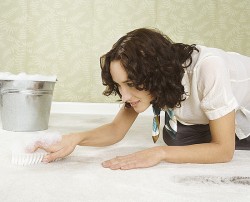First and foremost it should be made clear that black mold, or strachybotrys atra, scientifically, is toxic and deadly. Human beings exposed to black mold may experience respiratory problems like coughing, bronchitis, asthma, or bleeding in the lungs. In addition, they may have headaches, dizziness, memory loss, or nausea. Less common ailments with exposure are urinary tract infections and infertility. As you can see there are many black mold health risks. This is exactly why if you have it in your home, you need to know how to handle black mold removal.
So how do you know if you do indeed have black mold in your home? If you see dark green to black mold on your walls or ceilings, and can smell a bad, mildew type odor, chances are it is there. Black mold, like all other molds, grows where it is dark and damp, so basements, closets, and heating and air conditioning units are prime locations for it. If you have any type of flooding in your home, whether it be from a leaky pipe, overrun toilet, or heavy rains, the extra water can become a perfect habitat for unhealthy mold. Even if there is simply high humidity where you live, your chances for having black mold in your home are increased.
Once you determine you are dealing with this mold, you need to know the best way to complete the black mold removal. The general rule is that if the affected area is less than 10 square feet, you should be able to handle it yourself. If it is a larger contamination, or you simply do not want to tackle it yourself, call a professional. When cleaning the mold on your own, follow these steps.
1. Protect yourself by wearing a respiratory mask, eye protection, and gloves.
2. Seal off the area with plastic sheeting and tape, and turn off any type of air system, whether heating or cooling related.
3. Use a stiff brush to remove as much of the mold as possible. Place any debris in a bag.
4. Use a cleansing product to do the black mold removal. Use bleach, or a mold spray that is specifically for toxic mold. There are also paints available that seal in the area and prevent future mold from growing.
5. Rinse and repeat as necessary.
6. Make sure all debris and tools used get sealed securely in a bag so the mold can no longer spread.
7. Use a fan to dry the cleaned area, if necessary.
You should handle black mold removal as soon as you detect it. Within a 24 hour period it can spread considerably and become more dangerous. In the future, consider using a dehumidifier or exhaust fan in susceptible areas.

















